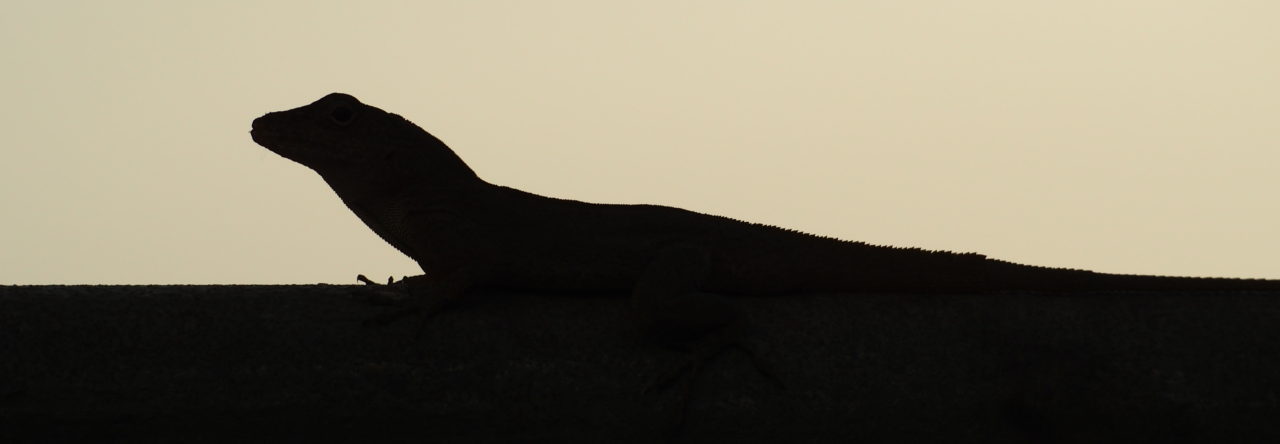
I just got back from a short trip down to Eleuthera in The Bahamas where I was assisting Anthony Geneva (Harvard post-doc) in sampling lizards. Also along for the trip were Sofia Prado-Irwin (Harvard Ph.D. student) and Rich Glor (University of Kansas). We went with the main goal of sampling Anolis sagrei from four habitat types found commonly in the Bahamas as an extension of an ongoing project in the Losos lab (previous posts from: Rum Cay, Concepcion Island, Ragged Island, Bimini, Mangrove habitat, and Great Isaac Cay). Specifically, we were looking to sample Anolis sagrei in mangrove, secondary coppice forest, closed coppice forest, and beach scrub habitats. These habitats differ in the height of the canopy, density of the understory, and composition of plants.
This slideshow requires JavaScript.
We focused entirely on the southern half of the island near Rock Sound and Cape Eleuthera. We were successful in sampling two beach scrub habitats, two mature coppice forest, one secondary coppice forest, and one mangrove habitat. We were able to catch all four of the anole species found on Eleuthera: Anolis angusticeps, Anolis distichus, Anolis sagrei, and Anolis smaragdinus. We also encountered a number of other native herp species: the Bahamian boa (Chilobothrus striatus), Ameiva auberi, Eleutherodactylus rogersi, curly tailed lizards (Leiocephalus carinatus), and the Bahamian racer (Alsophis voodoo), as well as a couple of non-native species: Cuban tree frog (Osteopilus septentrionalis), and Hemidactylus mabouia.
This slideshow requires JavaScript.
In my own research I work with Anolis cristatellus, the Puerto Rican crested anole. I am always surprised when I catch A. sagrei by how much smaller they are than A. cristatellus, although very similar in appearance otherwise. On this trip, I was also surprised that the A. sagrei, as well as the A. angusticeps and the A. smaragdinus, appeared to be much smaller than those I had encountered on Bimini last spring.
We also found that the density of lizards was quite low compared to what we expected and what I had experienced in Bimini, both during the day and at night. In all four of the habitat types, we saw an abundance of hatchlings, juveniles, females, and small males, but relatively few full adult male A. sagrei. For A. angusticeps and A. smaragdinus, we encountered only a few individuals total during the week of sampling. This reminded me of an odd experience I had last fall in Puerto Rico with A. cristatellus. It was the same time of year and I had an extremely difficult time locating mature animals in sites where I had previously sampled large numbers during the spring and summer months. Instead, I observed a large number of very young animals and females. I’m curious if this is a coincidence or if perhaps there is a strong seasonal effect on either male behavior (i.e., reduced visibility outside of the mating season) or male abundance (i.e., reduced numbers because of mortality during the mating season). In other words, are the males still there, but hiding, or are they really lower in abundance in the late fall? Or maybe I was coincidentally unlucky on both trips… I am very curious to hear thoughts on this!

Anolis sagrei using coral ground habitat.
Finally, I want to end with a short natural history note on the habitat use of the A. sagrei in the mangrove habitat. In this habitat we observed A. sagrei using perches at drastically different heights: some were 6 feet up, others were on the ground. Interestingly, the ones on the ground did not appear to be in transit, but seemed to be using the pockmarked karst as perches, running into one of the many holes when approached. Has any one else observed this behavior before? It seems so different from the typical trunk-ground anole perch and behavior to me.
That’s all for now. Currently Anthony is sampling additional islands in the Bahamas along with Melissa Kemp (Harvard post-doc) and Colin Donihue (Yale Ph.D. candidate / Harvard visiting student). Best of luck to them, I can’t wait to hear how the rest of the trip went!




![IMG_5612[1]](https://i0.wp.com/farm2.staticflickr.com/1603/24973410511_c2eee8971f_c.jpg?resize=629%2C420&ssl=1)
![IMG_5611[1]](https://i0.wp.com/farm2.staticflickr.com/1624/24699126379_d365d22614_c.jpg?resize=629%2C420&ssl=1)
![IMG_5610[1]](https://i0.wp.com/farm2.staticflickr.com/1445/24771217750_52b54cb15e_c.jpg?resize=629%2C420&ssl=1)
![IMG_5608[1]](https://i0.wp.com/farm2.staticflickr.com/1684/25040596346_7995af2423_c.jpg?resize=629%2C420&ssl=1)
![IMG_5607[1]](https://i0.wp.com/farm2.staticflickr.com/1663/25039699926_3d94c0c11d_c.jpg?resize=629%2C420&ssl=1)
![IMG_5626[1]](https://i0.wp.com/farm2.staticflickr.com/1441/25039756456_14f5237702_c.jpg?resize=629%2C420&ssl=1)
![IMG_5616[1]](https://i0.wp.com/farm2.staticflickr.com/1595/24698893089_fb7259ab28_c.jpg?resize=629%2C420&ssl=1)

























